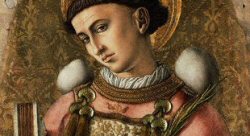From GoErie.com
By Dana Massing
The Rev. Edward Lohse said it’s too early to tell if America’s rough economy will mean an upswing in the number of Catholic priests and women religious. (This is the second or third time I've read this in an article. While it presented differently here, I don't like the idea that vocations to the Priesthood or Consecrated Life is something you do when you can't make a lot of money in the world.)
But he suspects it will.
“It’s got to cause people to look inside themselves somewhat,” he said.
Lohse, 47, chancellor and vocation director for the Catholic Diocese of Erie, believes it was the experiences of the Great Depression and World War II that led to the last explosion in the number of priests and nuns.
“It really made people look at the tough questions of life,” he said.
This week, the Catholic Church in the U.S. will encourage people, especially young people, to recognize where God is in their lives and perhaps answer his call. The Church is celebrating National Vocation Awareness Week through Saturday.
“This week reminds us that it is our responsibility to pray for vocations and to invite young people to consider a call to ordained ministry and consecrated life,” said the Rev. James Steffes, executive director of the Secretariat of Clergy, Consecrated Life and Vocations for the U.S. Conference of Catholic Bishops.
Some parishes desperately need people to answer that call.
Other churches around the country are either sharing pastors or turning to foreign-born priests to fill posts.
Lohse said the Erie diocese, which has 225,000 Catholics, doesn’t seek out foreign-born priests or candidates for seminary. He also said there are no parishes in the 13-county diocese where a priest shows up only once a month.
“There is no place that goes without Sunday Eucharist,” he said.
Some of the area’s religious men do serve multiple churches or serve a church and fill another role.
Members of Erie’s Immaculate Conception Church, whose pastor also teaches at Gannon University, said a declining number of priests was one reason they were given for their upcoming merger with St. Mary Church. Officials also cited a drop in membership in both parishes.
Asked if there was a priest shortage in the Erie diocese, Lohse said, “There is a shortage insofar as we have fewer priests than we used to ... which causes us to think through much more concretely the distribution of priests. We are able to meet all of our needs by the prudent distribution of resources, namely priests, matched to the distribution of Catholics.
“What that means, however, is we really can’t afford to send a priest somewhere for 20 people. ... There’s a day when we could have afforded that.”
Lohse believes the boom of priests and women religious in the 1950s and 1960s was a historical anomaly coming out of the Great Depression and World War II. Then the pendulum swung back the other way, he said.
Sister Janet Goetz, 61, vocation minister for the Benedictine Sisters of Erie, said the ’50s and ’60s were unusual years when large numbers of women entered monasteries or convents.
“Before and since those years, the average number of women entering (a convent) was one or two a year,” she said.
The newest member of her community took final vows in 2007, Goetz said.
Sister Sheila Stevenson, 61, vocation minister for the Sisters of Mercy of the Americas — New York, Pennsylvania, Pacific West Community, said she entered her religious community with 25 other women in 1965.
Numbers began going down after the Second Vatican Council, held in 1962-65, said Sister Linda Fusco, vocation director for the Sisters of St. Joseph of Northwestern Pennsylvania.
Fusco, 58, entered the local Sisters of St. Joseph 16 years ago and professed her final vows seven years ago. She’s the newest member of her community.
Before Vatican II, females could only serve in the church as women religious, she said.
The Rev. Michael Renninger, the Virginia priest behind an online vocation campaign, said that in years past, convents and seminaries were also places where Catholic girls and boys could get an education.
He also said that back in the 1950s, there was a lot of talk about becoming priests and nuns but that parents who heard so much of that have said little about it to their own children.
And those children now have opportunities apart from a committed religious life, with the laity able to do more in the church and more educational avenues open to Catholic students.
But Renninger believes not just the church is struggling.
He sees a decline in what he called “helping professions” — social work, nursing, education. He believes it’s “part of a bigger cultural thing,” a definition of success in which people place more focus on money and material things than aiding others.
Still, local vocation directors believe trends in religious vocations could change again.
Interest in vocations
“There are indications of a shift,” Goetz said. “More women are ... indicating interest in long-term commitments.”
Lohse said, “I think they are headed back toward an equilibrium that is probably more the historical norm. When we will arrive at that equilibrium, I don’t know.”
He said it’s not that young people aren’t interested in a vocation to religious life.
“I think it’s very difficult for a young person today to hear the call in such a way that he or she is really free to act upon it,” Lohse said. “The culture doesn’t encourage it. A lot of parents are opposed to it. And some of them, I think, just don’t know what to do with it.”
The priest said one of the purposes of a minor seminary like Erie’s St. Mark is to help men find answers. St. Mark currently has six seminarians. The Erie diocese has 10 other men attending major seminaries.
In the past 20 years, about half of the men from the Erie diocese who entered seminary have gone on to become priests, Lohse said.
“We are happy with that because we are accomplishing our purpose,” he said. “We are helping young men to answer the question, ‘Is this what I was meant to do?’”
Seeking in different ways
Fusco said she’s seen statistics showing a 65 percent increase in inquiries about vocations across the country in the past year.
These days, many of them arrive via e-mail.
Stevenson said the Mercy Sisters have a private Internet chat room where interested women can meet and talk with some of the sisters about religious life.
Lohse said the chief way his diocese keeps in touch with priest candidates is text messaging.
Renninger, 45, remembers having to write letters with stamps to get vocation information.
Now the Virginia priest from the Catholic Diocese of Richmond has organized Behind the Collar, a campaign providing a look at the priesthood via a Web site, Facebook and YouTube.
In their first three months, the Web site received 1,850 views and the Facebook and YouTube pages had more than 800 each, Renninger said.
He said his diocese of 225,000 Catholics hasn’t had a dramatic drop in priests, but is facing a moderate decline in the next 10 years.
For many of the men and women called to a religious life, aging doesn’t mean retiring.
Fusco said women in her community technically retire at age 70, but usually enter a new ministry, work part time or volunteer.
“Anyone who’s capable of doing something is doing it,” she said.
The ones who can’t because of health problems “pray for the rest of us” and for other people, Fusco said.
Adapting to the times
Sisters have opened orphanages, hospitals and schools. They’ve nursed, done social work and fought for social justice.
A fourth-grade teacher at Blessed Sacrament School, Fusco is one of the few local sisters still in the classroom. As different people have come forward to provide education, sisters have graduated to filling other roles in the community.
“We minister to the needs of the times,” Fusco said.
They also change to meet them.
In 2008, Erie Sisters of Mercy joined those from Buffalo, Rochester, Pittsburgh and the Philippines in the single large group known as the New York, Pennsylvania, Pacific West Community. They total about 500 sisters and more hands help lighten the load, officials said.
Stevenson said that coming together allowed the sisters to continue their mission of serving the poor, sick and uneducated while being more economical.
Promoting vocations
All the vocation directors said they try to get the word out about who they are and what they do.
Sisters plan open houses. At Fusco’s school, children pray for vocations and she talks about National Vocation Awareness Week.
The diocese has a discernment program to help college men discover whether they’ve been called to a priestly vocation.
Local priests and sisters are optimistic about the future.
“I certainly would hope that there would be women religious to continue the work in the church, to keep serving the needs of the people and that’s what it’s all about, to serve other people and God,” Fusco said.
If you are actively discerning a vocation to the Priesthood, Diaconate, Consecrated Life, or Marriage and you are looking for information to help in your discernment, BE SURE TO CHECK the section at the bottom of the right sidebar for the "labels" on all posts. By clicking on one of these labels it will take you to a page with all posts containing that subject. You will also find many links for suggested reading near the bottom of the right sidebar. Best wishes and be assured of my daily prayers for your discernment.

Subscribe to:
Post Comments (Atom)























1 comment:
This is a good article, however, I do think we have to acknolwedge some truth to the reasons why people enter religious life and seminary. I have spoken to a few of my seminary professors and they acknowledge the economic factor as a reason for some men to enter the seminary.
Whaterver the case, I think this shows that God will is done inspite of the motives of those whom are seeking religious life.
God BLess
This is a great web site!!!
Keep up the good work.
Regards,
Reggie
Post a Comment